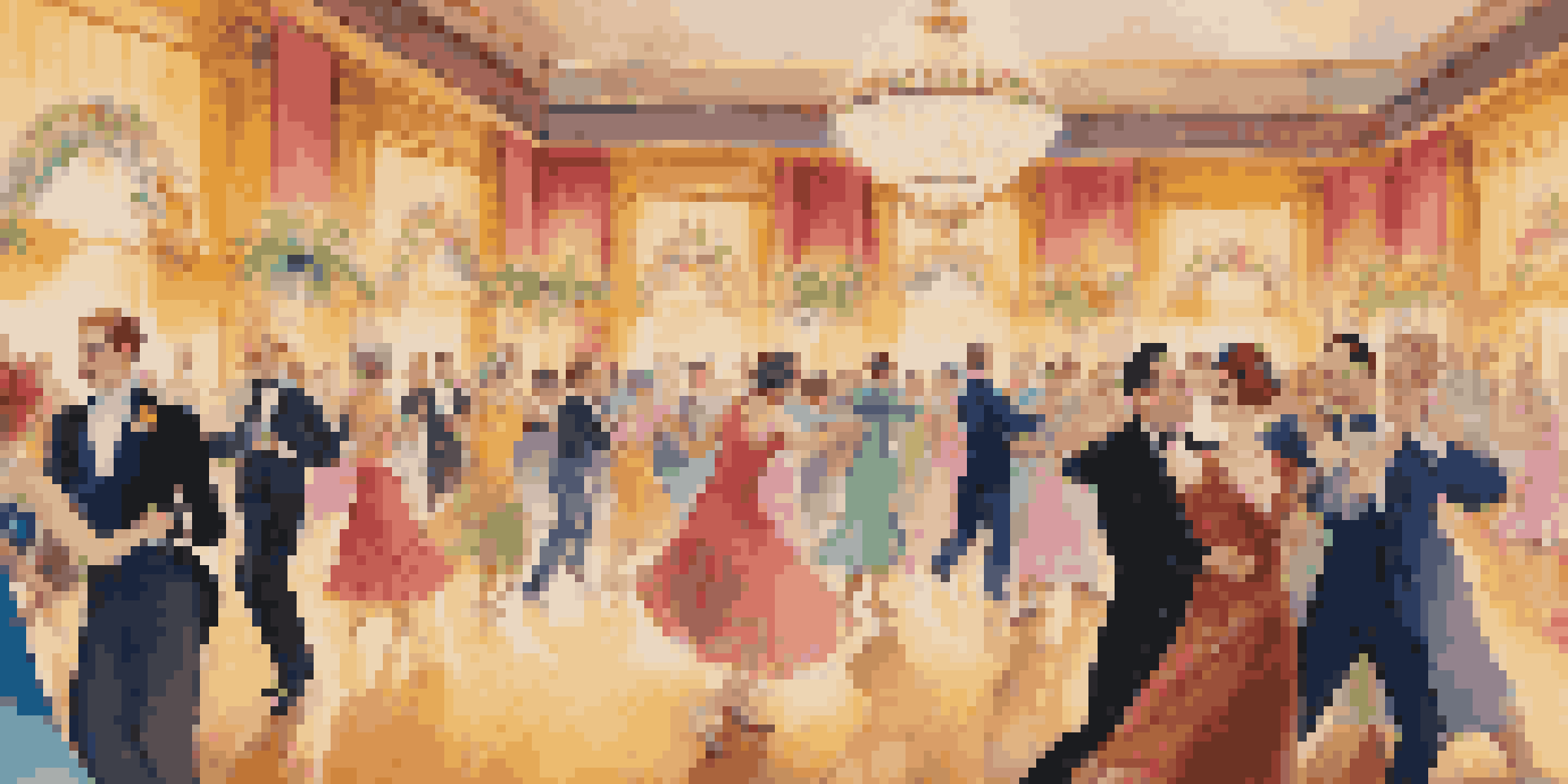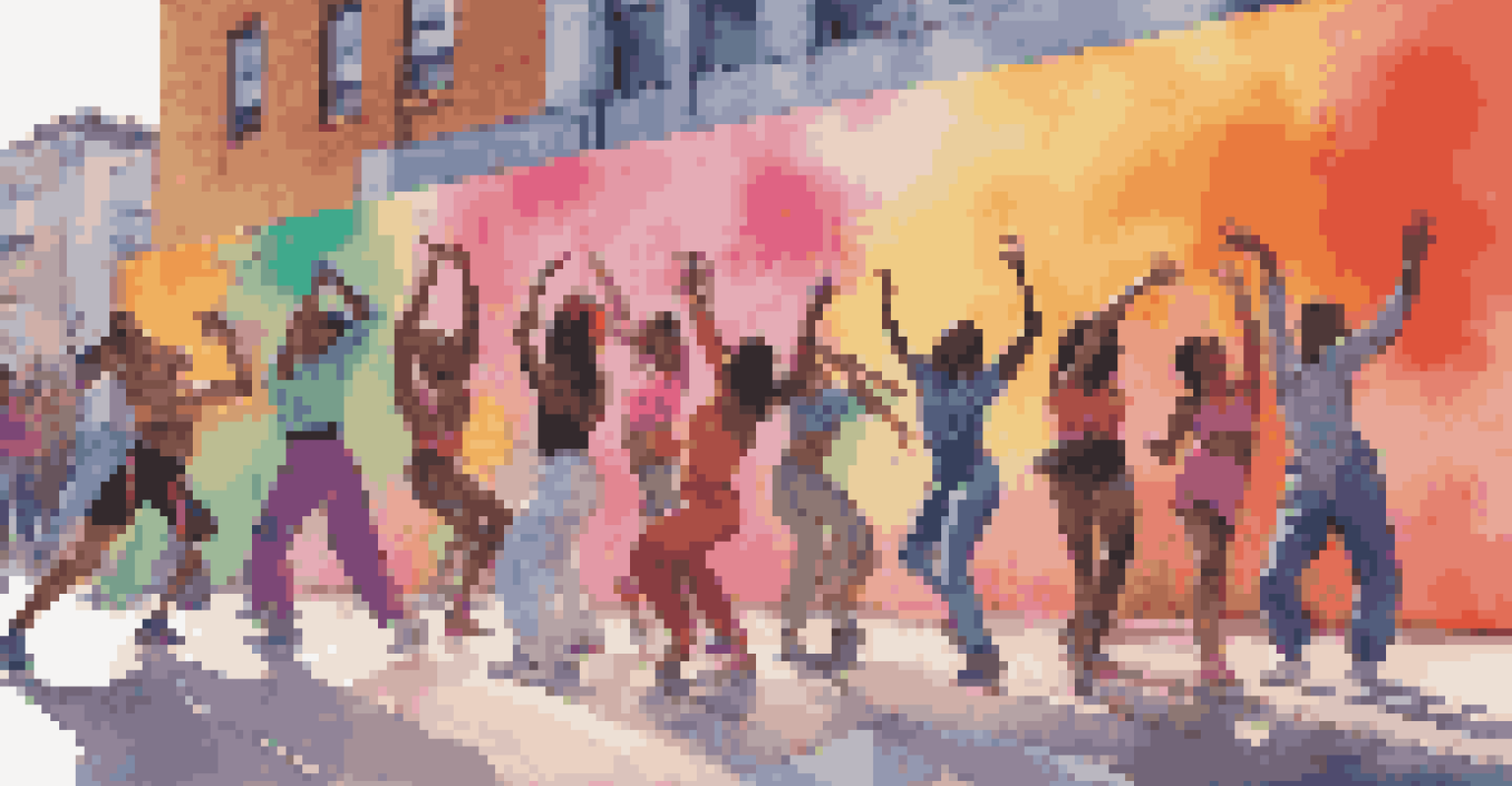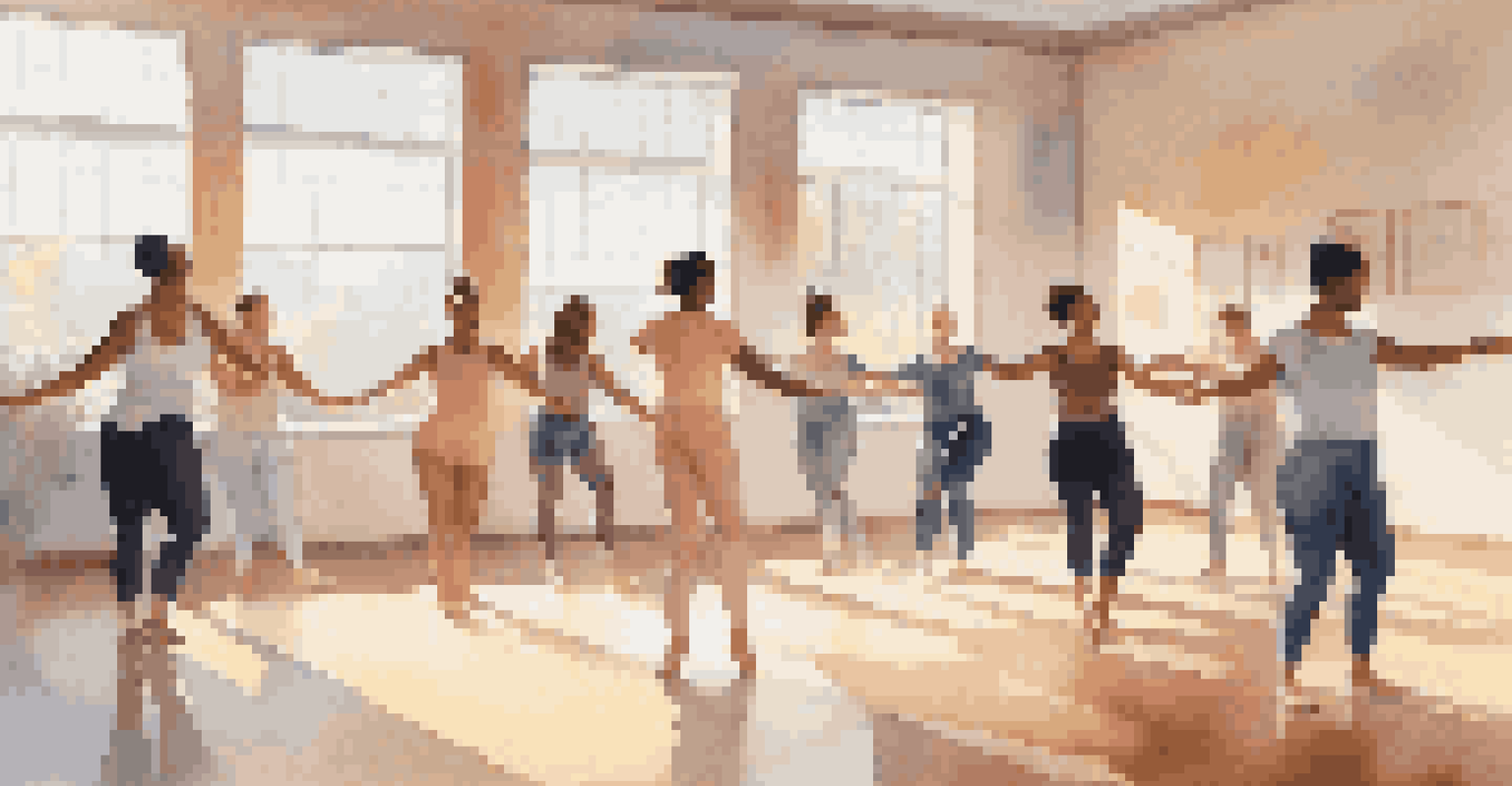The Role of Dance in LGBTQ+ Gender Expression and Identity

The Historical Connection Between Dance and LGBTQ+ Culture
Dance has long served as a vibrant outlet for LGBTQ+ communities, tracing back to historical gatherings where expression was a form of resistance. From the flamboyant balls of the 1920s to the underground clubs of the 1980s, these spaces became crucial for marginalized voices. In these environments, dance not only allowed for self-expression but also fostered a sense of belonging, creating community bonds.
Dance is the hidden language of the soul.
For many LGBTQ+ individuals, these dance spaces were safe havens where they could explore their identities without fear of judgment. The freedom to express oneself through movement often translated into a deeper understanding of personal identity. As dance evolved, it became a powerful tool for storytelling, encapsulating the struggles and triumphs of the LGBTQ+ experience.
Moreover, the emergence of iconic dance forms like voguing and waacking highlighted the intersection of art and activism. These styles, deeply rooted in LGBTQ+ culture, not only celebrate diversity but also challenge societal norms. Thus, dance continues to play a pivotal role in the historical tapestry of LGBTQ+ identity.
Dance as a Form of Self-Expression for LGBTQ+ Individuals
For many, dance acts as a personal language, allowing individuals to communicate feelings that words often fail to capture. The act of moving one's body can provide a sense of liberation, enabling LGBTQ+ individuals to express their gender identity and sexuality confidently. This form of self-expression often leads to greater self-acceptance and empowerment.

Through dance, individuals can explore and redefine their identities in a way that feels authentic to them. Whether it's through fluid movements or bold gestures, each dance style can embody different aspects of one's gender expression. This exploration is crucial in a world where rigid gender norms still exist.
Dance as Identity Expression
Dance serves as a powerful medium for LGBTQ+ individuals to explore and express their identities authentically.
Additionally, dance can serve as a therapeutic outlet, helping individuals process emotions related to their identity. Many find solace in dance, using it as a tool for healing and growth. This transformative power of movement is what makes dance such an integral part of the LGBTQ+ experience.
The Impact of Dance on LGBTQ+ Community Building
Dance has an unparalleled ability to bring people together, fostering connections within the LGBTQ+ community. Dance events, whether they are formal balls or informal gatherings, create spaces where individuals can mingle, share experiences, and build friendships. This sense of community is vital, especially for those who may feel isolated due to their identity.
The dance is a poem of which each movement is a word.
At these events, the act of dancing itself becomes a collective experience, uniting people through rhythm and movement. The joy of dancing with others can break down barriers and create lasting bonds. It's not just about the dance; it's about the shared experiences and mutual understanding that accompany it.
Moreover, community dance projects and workshops often foster inclusivity, allowing participants to learn from one another. These collaborative environments encourage creativity and expression while reinforcing the idea that everyone’s journey is valid. Ultimately, dance acts as a glue that holds the LGBTQ+ community together.
Dance Genres That Celebrate LGBTQ+ Identity
Various dance genres have emerged as significant forms of expression within the LGBTQ+ community, each celebrating diverse identities. Styles like voguing, with its sharp poses and dramatic flair, originated in ball culture and exemplify the celebration of individuality. This genre not only showcases unique gender expressions but also highlights the importance of visibility within the community.
Similarly, contemporary dance has become a platform for LGBTQ+ artists to tell their stories and challenge conventions. Through choreographed pieces, dancers explore themes of gender fluidity, love, and social justice, pushing audiences to think critically about identity. This genre serves as a canvas for exploring complex narratives that resonate with many.
Community Building Through Dance
Dance fosters connections within the LGBTQ+ community, creating safe spaces for shared experiences and friendship.
Additionally, traditional dance forms are often reimagined to reflect LGBTQ+ experiences, creating a blend of the old and new. By incorporating elements of personal identity into these established genres, dancers can honor their roots while embracing their true selves. This fusion not only enriches the dance community but also promotes inclusivity.
Dance as a Tool for Advocacy and Activism
Dance has been utilized as a powerful tool for advocacy within the LGBTQ+ community, amplifying voices and raising awareness. Through performances that tackle social issues, dancers can engage audiences on topics like discrimination, equality, and acceptance. This ability to convey messages through movement makes dance a unique and impactful form of activism.
Moreover, events like Pride parades often feature dance performances that celebrate LGBTQ+ identities while fostering visibility. These performances serve not only as entertainment but also as a reminder of the ongoing struggles faced by the community. The combination of celebration and activism allows for a deeper connection with the audience, fostering empathy and understanding.
In recent years, social media has further transformed how dance is used for advocacy, allowing dancers to reach broader audiences. Viral dance challenges and campaigns can bring attention to important issues, spreading messages of love and acceptance worldwide. This integration of dance and digital platforms exemplifies the evolving nature of activism in the LGBTQ+ community.
The Therapeutic Benefits of Dance for LGBTQ+ Individuals
Dance therapy has emerged as a valuable resource for LGBTQ+ individuals seeking emotional and psychological support. The act of dancing allows for the expression of feelings that may be difficult to articulate, providing a healthy outlet for stress and anxiety. This therapeutic approach can be particularly beneficial for those navigating the complexities of their identities.
In dance therapy, individuals can explore their bodies and emotions in a safe environment, fostering self-awareness and healing. The physicality of dance can stimulate endorphins, helping to alleviate feelings of depression or isolation. For many, this practice can lead to greater confidence and a more positive self-image.
Advocacy Through Movement
Dance acts as a tool for advocacy, amplifying LGBTQ+ voices and raising awareness about social issues.
Additionally, group dance therapy sessions promote a sense of belonging, connecting participants through shared experiences. This communal aspect reinforces the idea that no one is alone in their journey, allowing individuals to find solace in one another. Ultimately, the therapeutic benefits of dance extend far beyond the studio, impacting overall well-being.
The Future of Dance in LGBTQ+ Expression and Identity
As society continues to evolve, so does the role of dance in LGBTQ+ expression and identity. With increasing visibility and acceptance, more individuals are embracing dance as a means to explore their identities openly. This shift not only empowers dancers but also encourages audiences to engage with diverse narratives.
The rise of digital platforms has also transformed how dance is shared and experienced, allowing for greater accessibility. Emerging dancers from all backgrounds can showcase their work, fostering innovation and creativity within the community. This democratization of dance opens doors for new styles and voices to emerge.

Looking ahead, the fusion of dance with other art forms will likely continue to shape how LGBTQ+ identities are expressed. Collaborations across mediums can create powerful statements, inviting audiences to reflect on issues of identity and belonging. The future of dance promises to be as vibrant and diverse as the community it represents.